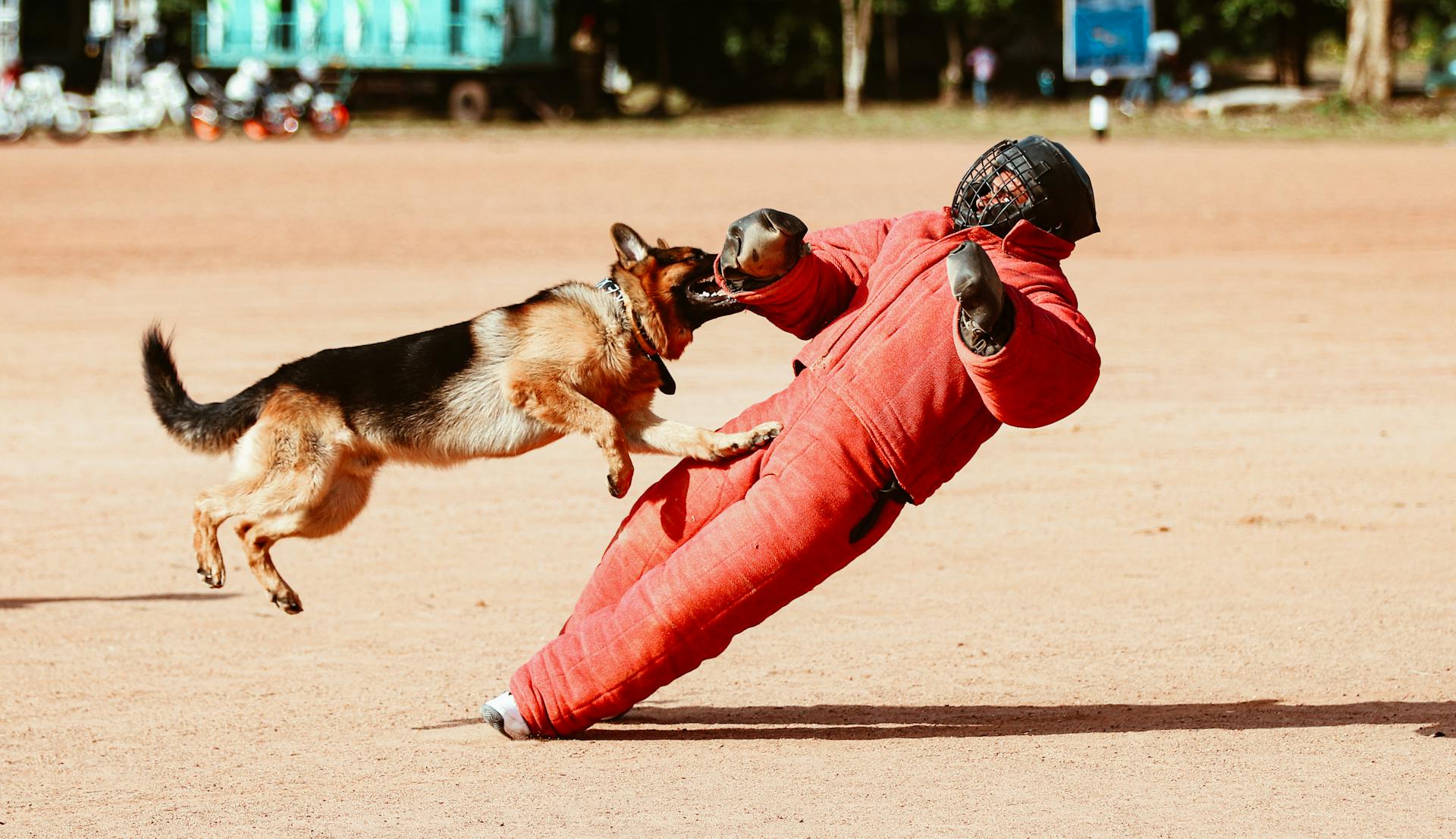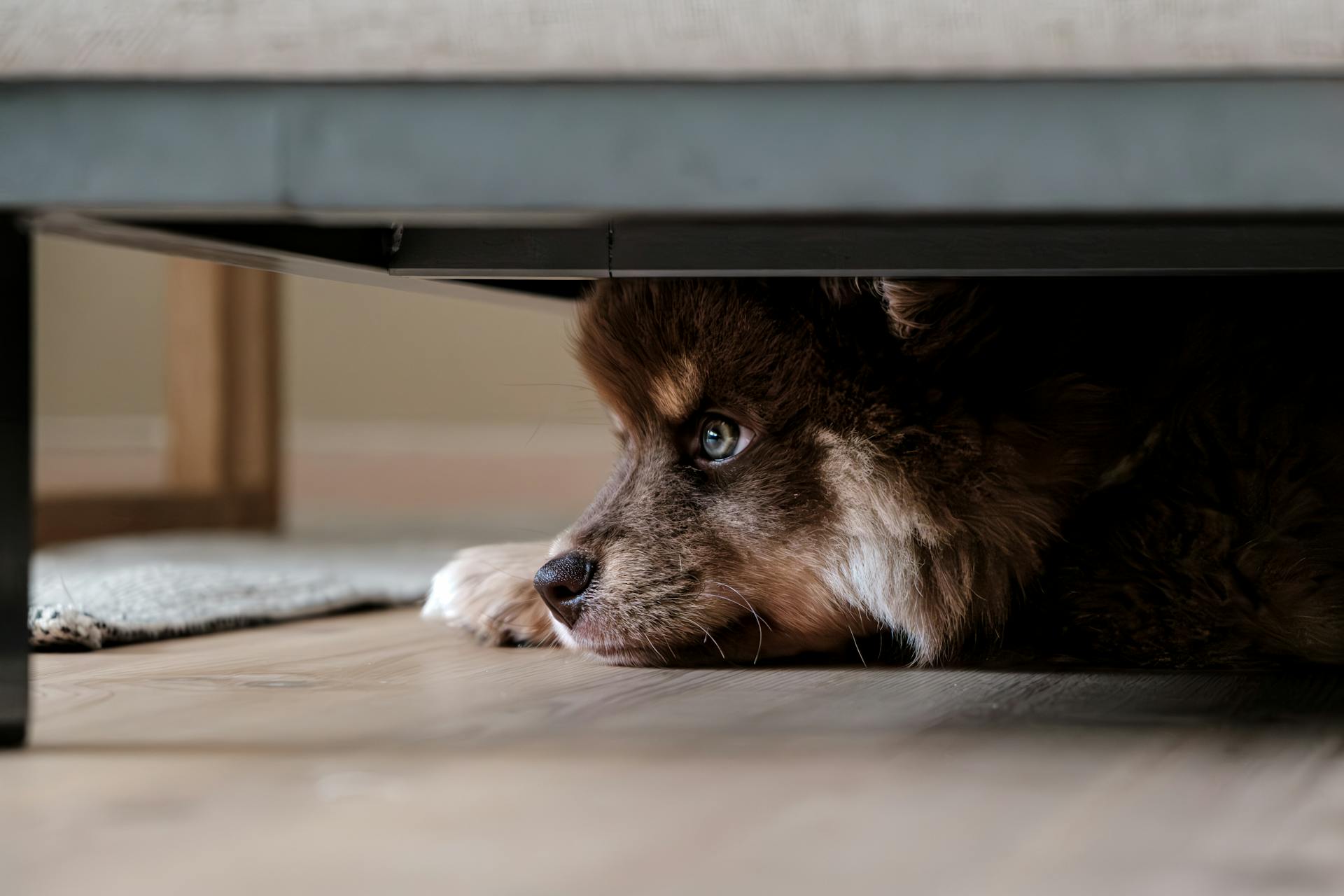
Elbow dysplasia is a common health issue affecting German Shepherds, particularly between 1-3 years of age. The condition occurs when the joint between the radius and ulna bones in the elbow doesn't form properly.
German Shepherds are prone to this condition due to their rapid growth rate and genetic predisposition. This can lead to arthritis and mobility problems if left untreated.
Elbow dysplasia can be caused by a combination of genetic and environmental factors, including improper nutrition and exercise. A German Shepherd's diet and exercise routine can play a significant role in preventing or managing the condition.
Additional reading: Treat Elbow Calluses
What is Elbow Dysplasia?
Elbow dysplasia is a common disorder that affects young dogs, usually under one year of age, and is more prevalent than hip dysplasia in some breeds.
Labrador Retriever, Golden Retriever, Bernese Mountain, German Shepherd, Newfoundland, and Rottweiler are breeds that are over-predisposed to elbow dysplasia.
The problem is a congenital, hereditary disease that involves malalignment of the bones of the elbow joint, also called joint incongruency.
For more insights, see: Treat Dog Elbow Callus
This mal-alignment causes abnormal pressure or joint loading, and chronic rubbing which wears away the cartilage resulting in severe osteoarthritis.
Elbow dysplasia can be broken down into numerous underlying pathologies, including fragmented medial coronoid process, osteochondritis dissecans, and medial compartment syndrome.
Definitive diagnosis is made via CT scanning and arthroscopic examination.
Clinical Signs
If you suspect that your German Shepherd is suffering from elbow dysplasia, it's essential to recognize the clinical signs.
Limping or lameness is the primary clinical sign of canine elbow dysplasia, often accompanied by head bobbing at a fast walk or slow trot.
Dogs with elbow dysplasia may be reluctant to go for long walks or play for long periods of time, and may exhibit limited range of motion in the elbow joints.
Pain on elbow extension and flexion is a common symptom, which can cause discomfort and difficulty when lying down in sternal position.
Here are some common signs of elbow dysplasia in German Shepherds:
- Pain
- Decreased range of motion
- Loss of muscle mass (muscle atrophy)
- Abnormal posture when standing, getting up, lying down or sitting
- Abnormal gait when walking, trotting, climbing stairs or turning
- Swelling and inflammation
- Grating or grinding joint movement
Diagnosis and Tests
Diagnosis of elbow dysplasia in German Shepherds typically involves a combination of physical examination, radiographs (X-rays), and computerized tomography (CT scans). The diagnosis can also be made fairly accurately based on physical examination and simple X-rays alone.
A physical examination is a crucial step in diagnosing elbow dysplasia, where the veterinarian observes the mechanics of how your dog walks, noting any abnormalities. This gait evaluation helps identify potential issues with the elbow joint.
Radiographs, or X-rays, show the overall health of the elbow joint and the degree of pre-existing osteoarthritis. However, what is often seen on X-rays are secondary joint remodeling changes that are consistent with elbow dysplasia, rather than the actual incongruency.
CT scans are more sensitive and offer numerous advantages compared to standard radiographs, as they can best show joint incongruency and FMCP (fragmented medial coronoid process) non-invasively. This makes CT scans a valuable diagnostic tool for elbow dysplasia.
Here's an interesting read: Prevent Dog Elbow Calluses
The diagnosis of elbow dysplasia can also involve arthroscopy, which is used both as a diagnostic tool and to treat the condition. During arthroscopy, the surgeon makes small incisions on the inside of the elbow and inserts an arthroscope to provide high-resolution images of the inside of the joint.
Here is a summary of the diagnostic process:
It's worth noting that elbow dysplasia is a genetic orthopedic condition, meaning that a dog who's been diagnosed with elbow dysplasia always has elbow dysplasia.
Causes and Conditions
Elbow dysplasia in German Shepherds is often the result of a combination of genetic and environmental factors. Genetic predisposition is a major contributor, with some breeds being more prone to the condition.
The condition can arise from an abnormal formation of the elbow joint, causing the bones to rub against each other and leading to arthritis and pain. This abnormal formation can be influenced by the dog's genetics and the way the joint develops during growth and development.
The size of the dog can also play a role, as larger breeds like German Shepherds are more likely to develop elbow dysplasia due to their rapid growth rate and joint stress.
Discover more: What Are the 5 Types of German Shepherds
Is Common?

Is Elbow Dysplasia in Dogs Common?
Elbow dysplasia, or ED, is more common in young, large breed dogs. This means that if you have a big dog, you should be aware of the risk.
Specific breeds with a high disposition to ED include Labrador retriever, Newfoundland, Rottweiler, German Shepherd, English Springer Spaniel, and Golden retriever.
Medial Compartment Disease
Medial compartment disease is a severe and advanced stage of elbow dysplasia.
In dogs with chronic severe elbow dysplasia, all the cartilage on the medial aspect of the joint is often worn away.
This condition is difficult to treat successfully.
Arthroscopy can be used to remove any free fragments and debris from the joint.
Several osteotomies, such as the proximal dynamic ulnar osteotomy and PAUL procedure, can also be used to treat medial compartment syndrome with variable results.
Platelet rich plasma has shown some promise for short-term improvement, but it won't promote cartilage regrowth.
Elbow replacement is available, but the procedure is new and long-term results are not yet available.
Medial compartment disease is a challenging condition that requires careful consideration and a thorough diagnosis.
Treatment and Recovery
Non-surgical treatments for elbow dysplasia in German Shepherds may include physical therapy, weight management, exercise modification, and glucosamine supplements. These options can help manage pain and improve joint function.
Surgical treatment options are available, and arthroscopy is often performed to evaluate pathology and provide treatment. Arthroscopy involves a small "poke hole" into the joint, allowing for thorough examination and removal of bone and cartilage fragments.
Dogs undergoing arthroscopic elbow surgery have a fair to excellent prognosis, depending on the exact diagnosis and degree of incongruency. Removing free fragments and minimizing abnormal joint contact can help prevent progressive osteoarthritis.
Here are some common non-surgical treatment options:
- Physical therapy
- Weight management
- Exercise modification
- Glucosamine supplements
- PRP, hyaluronic acid, or stem cell injections
Surgical treatment options include arthroscopy, osteotomy, and a combination of both. Arthroscopy allows for thorough examination and removal of bone and cartilage fragments, while osteotomy involves cutting and realigning bones to improve joint function.
Typical Treatment
Pain relief medication is often the first line of treatment for canine elbow dysplasia, helping to manage pain and discomfort.

Non-surgical treatments like exercise management, body weight control, and physio/hydrotherapy can also be effective in improving elbow function and reducing pain.
Joint supplements, such as glucosamine, may be prescribed to help alleviate joint pain and inflammation.
Surgery is typically reserved for more severe cases of elbow dysplasia, where non-surgical treatments have failed to provide relief.
Here are some common surgical options for treating canine elbow dysplasia:
As with any surgical procedure, it's essential to discuss the potential risks and complications with your veterinarian or surgeon to ensure you're making an informed decision for your furry friend.
Cost of Treatments
The cost of elbow disorder treatments can vary greatly depending on the specific procedure and the factors involved. At Colorado Canine Orthopedics, the average cost of an elbow arthroscopy can differ from patient to patient.
Factors such as the patient's condition and the surgeon's expertise can affect the overall cost. A pre-consultation estimate can be obtained by contacting the office to discuss the specifics of the case.

Fees for elbow arthroscopy include anesthesia and monitoring, nerve blocks when needed, and routine go-home medication. The cost of radiographs and CT scans are charged separately and should be discussed at the time of the initial consultation.
Osteotomies, when required, are charged for separately and should be discussed on a case-by-case basis.
A different take: When Do German Shepherds Shed
Frequently Asked Questions
How long do dogs live with elbow dysplasia?
Dogs with elbow dysplasia can live a normal lifespan with proper care and treatment. With a good diet, exercise, and treatment, they can enjoy a good quality of life.
Featured Images: pexels.com


